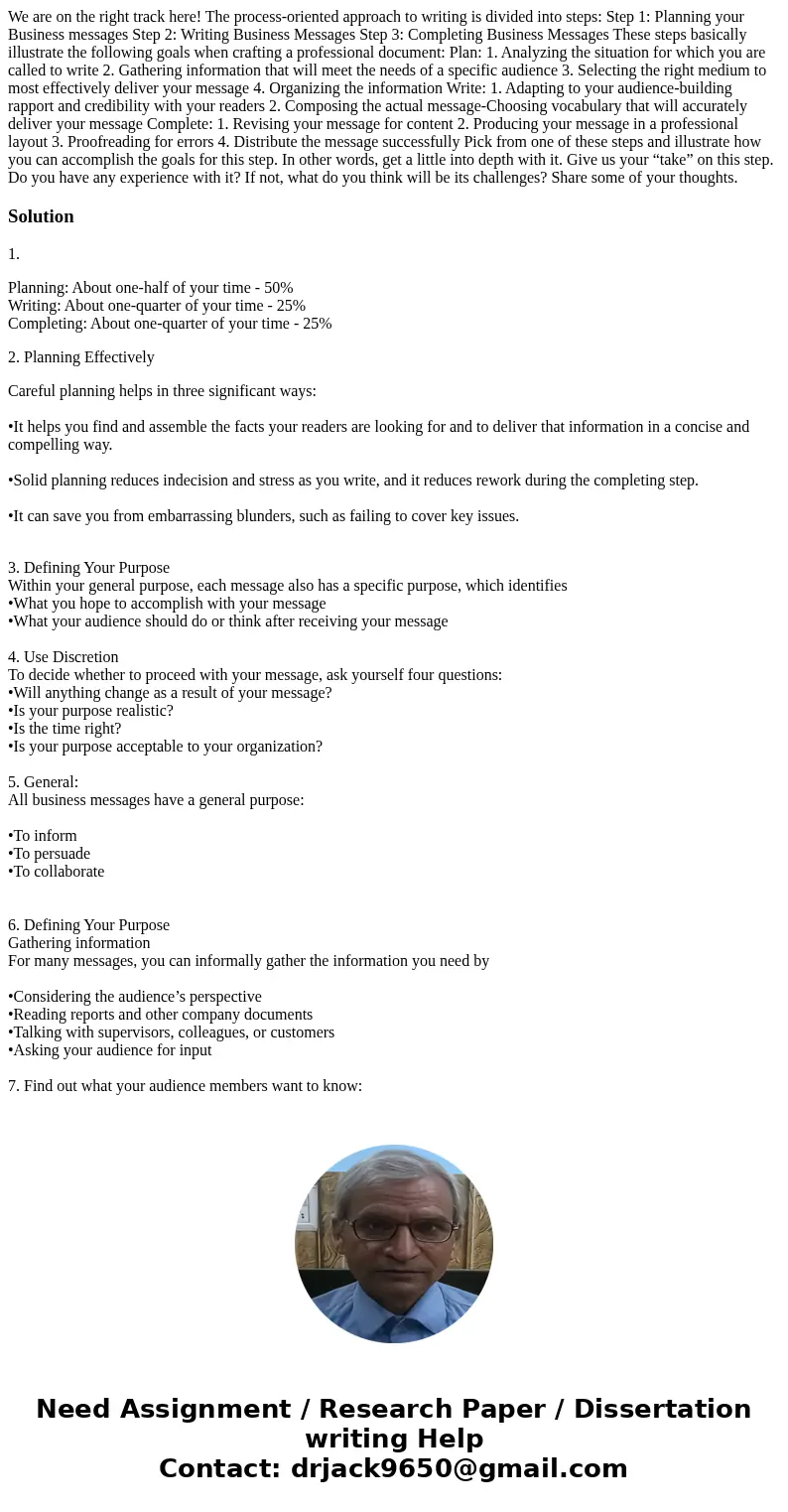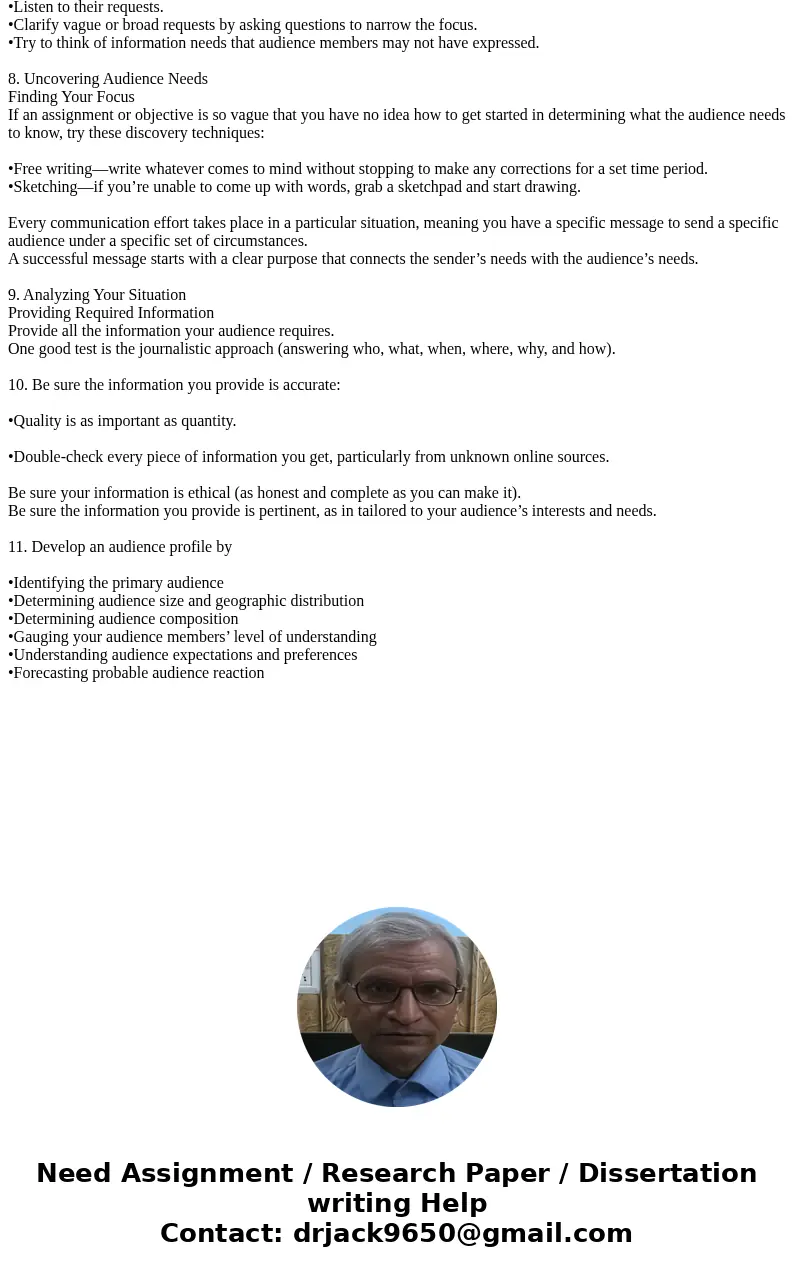We are on the right track here The processoriented approach
We are on the right track here! The process-oriented approach to writing is divided into steps: Step 1: Planning your Business messages Step 2: Writing Business Messages Step 3: Completing Business Messages These steps basically illustrate the following goals when crafting a professional document: Plan: 1. Analyzing the situation for which you are called to write 2. Gathering information that will meet the needs of a specific audience 3. Selecting the right medium to most effectively deliver your message 4. Organizing the information Write: 1. Adapting to your audience-building rapport and credibility with your readers 2. Composing the actual message-Choosing vocabulary that will accurately deliver your message Complete: 1. Revising your message for content 2. Producing your message in a professional layout 3. Proofreading for errors 4. Distribute the message successfully Pick from one of these steps and illustrate how you can accomplish the goals for this step. In other words, get a little into depth with it. Give us your “take” on this step. Do you have any experience with it? If not, what do you think will be its challenges? Share some of your thoughts.
Solution
1.
Planning: About one-half of your time - 50%
Writing: About one-quarter of your time - 25%
Completing: About one-quarter of your time - 25%
2. Planning Effectively
Careful planning helps in three significant ways:
•It helps you find and assemble the facts your readers are looking for and to deliver that information in a concise and compelling way.
•Solid planning reduces indecision and stress as you write, and it reduces rework during the completing step.
•It can save you from embarrassing blunders, such as failing to cover key issues.
3. Defining Your Purpose
Within your general purpose, each message also has a specific purpose, which identifies
•What you hope to accomplish with your message
•What your audience should do or think after receiving your message
4. Use Discretion
To decide whether to proceed with your message, ask yourself four questions:
•Will anything change as a result of your message?
•Is your purpose realistic?
•Is the time right?
•Is your purpose acceptable to your organization?
5. General:
All business messages have a general purpose:
•To inform
•To persuade
•To collaborate
6. Defining Your Purpose
Gathering information
For many messages, you can informally gather the information you need by
•Considering the audience’s perspective
•Reading reports and other company documents
•Talking with supervisors, colleagues, or customers
•Asking your audience for input
7. Find out what your audience members want to know:
•Listen to their requests.
•Clarify vague or broad requests by asking questions to narrow the focus.
•Try to think of information needs that audience members may not have expressed.
8. Uncovering Audience Needs
Finding Your Focus
If an assignment or objective is so vague that you have no idea how to get started in determining what the audience needs to know, try these discovery techniques:
•Free writing—write whatever comes to mind without stopping to make any corrections for a set time period.
•Sketching—if you’re unable to come up with words, grab a sketchpad and start drawing.
Every communication effort takes place in a particular situation, meaning you have a specific message to send a specific audience under a specific set of circumstances.
A successful message starts with a clear purpose that connects the sender’s needs with the audience’s needs.
9. Analyzing Your Situation
Providing Required Information
Provide all the information your audience requires.
One good test is the journalistic approach (answering who, what, when, where, why, and how).
10. Be sure the information you provide is accurate:
•Quality is as important as quantity.
•Double-check every piece of information you get, particularly from unknown online sources.
Be sure your information is ethical (as honest and complete as you can make it).
Be sure the information you provide is pertinent, as in tailored to your audience’s interests and needs.
11. Develop an audience profile by
•Identifying the primary audience
•Determining audience size and geographic distribution
•Determining audience composition
•Gauging your audience members’ level of understanding
•Understanding audience expectations and preferences
•Forecasting probable audience reaction


 Homework Sourse
Homework Sourse